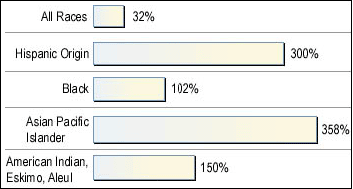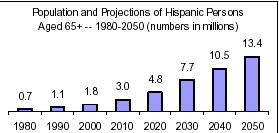19.
Hispanic American Elders
v Introduction
Over 35.6 million Americans are aged 65 and over. Three in five people in this age group are women. Over the next forty years, the number of people aged 65 and older is expected to double and the number of people aged 85 and older is expected to triple. Along with general trends for America's population, Hispanic populations are living longer.
The Hispanic elderly population will be the second most rapidly growing segment between 1990 and 2020.
|
|
|
|
The Hispanic older population was 2.0 million in 2002 and is projected to
grow to over 13 million by 2050. In percentage terms, the 2002 Hispanic persons
made up 5.5 percent of the older population. By 2050, the percentage of the
older population that is Hispanic is projected to account for 16 percent of the
older population. By 2028, the Hispanic population aged 65 and older is
projected to be the largest racial/ethnic minority group in the 65+ age group. Residence In 2002, 72% of Hispanic persons aged 60 and over resided in four states:
California (27%), Florida (16%), New York (9%), and Texas (20%). Educational Level Despite the overall increase in educational attainment among older Americans,
there are still substantial educational differences among racial and ethnic
groups. In 2002, about 35 percent of the Hispanic population aged 65 and older
had finished high school, compared with 70 percent of the total older
population. Also in 2002, 5.5 percent of Hispanic older Americans had a bachelorís
degree or higher, compared with 16.7 percent of all older persons. Living Arrangements
v The Older Hispanic Population: Past, Present, and Future
In 2000, 68 percent of Hispanic older men lived with their spouses, 16 percent lived with other relatives, 3 percent lived with non-relatives, and 14 percent lived alone. For older Hispanic older women, 38 percent lived with their spouses, 34 percent lived with other relatives, 3 percent lived with non-relatives, and 25 percent lived alone. Although older women are more likely to live alone than are older men for both populations, the percent of Hispanic elderly men and women living alone is lower than that of the general population. Also, the percent of Hispanic elderly living with other relatives is about twice that of the total population.
Poverty
The poverty rate in 2002 for Hispanic elderly (65 and older) was 21.4 percent, which was more than twice the percent for the total older population (10.4 percent).
Health
In 2003, only 28 % of Hispanic persons aged 65+ had received pneumococcal vaccination as compared to 58% of non-Hispanic whites and 34% of non-Hispanic blacks ( 2003 National Health Interview Survey). In 2003, 7.4% of Hispanic persons aged 65+ needed help from other persons for personal care as compared to 5.1% for non-Hispanic whites and 7.9% of non-Hispanic blacks (2003 National Health Interview Survey).
In 2003, 15.8% of all persons aged 65+ (Hispanic and non-Hispanic) were diagnosed with diabetes. The rate among Hispanic persons is higher since the age-adjusted rate among Hispanic persons is 44% higher than for non-Hispanic whites (National Health Interview Survey)
Self-Rated Health Status
During 1999, about 65 percent of Hispanic older men and 70 percent of Hispanic older women reported good or excellent health. Among the total 65+ population, this figure was 76 percent for men and 74 percent for women. Positive health evaluations decline with age. During 1994-1996, among Hispanic men ages 65-74, 69 percent reported good or excellent health, compared with 51 percent among those aged 85 or older. Similarly, among Hispanic women this rate declined from 65 percent at age 65-74 to 55 percent at age 85 or older.
In 1998, about 2 percent of Hispanic older persons reported that they had difficulty in obtaining medical care; 5 percent reported delays in obtaining health care due to cost, and 5 percent reported they were unsatisfied with the health care which they received. The comparable figures for the total population aged 65 or older were: 2 percent reported that they had difficulty in obtaining medical care, 4 percent reported delays in obtaining health care due to cost, and 3 percent reported that they were unsatisfied with the health care they received.
Access to Medical Care
Participation in Older Americans Act Programs. In 2002, State and Area Agencies on Aging provided services to a total of 7.5 million persons aged 60 and older. Consistent with the targeting requirements of the OAA, the "aging network" placed considerable emphasis on services to persons with the greatest social and economic need, including members of racial and ethnic minority groups, especially those who are poor. Among the OAA Title III service recipients, 6.1 percent were Hispanic elderly.
Data are from a variety of U.S. Government sources with differing sample sizes and designs. Much of this data is adapted from Older Americans 2000: Key Indicators of Well-Being, Appendix A: Detailed Tables including later updates. (See: http://www.agingstats.gov.) The last section, Participation in Older Americans Act Programs, reports data collected from State Agencies on Aging about persons served with Older Americans Act funds.
Diversity of Hispanic Elders
The racial and ethnic diversity of the Hispanic American population is exemplified by its many distinct ethnic groups. The members of these groups have unique languages, cultures and religions, and are diverse in terms of education levels and socioeconomic status. Among Hispanic elders living in the United States, nearly 49 percent are of Mexican descent, 15 percent are of Cuban descent, 12 percent are of Puerto Rican descent, and 25 percent are other Hispanic heritage.
Health and Chronic Illnesses
The leading disease-related causes of death for Hispanic Americans include heart disease, cancer, HIV infection, cerebrovascular diseases, pneumonia, influenza, and diabetes. While the Medicare program covers vaccinations to prevent pneumonia, annually only 15 percent of Hispanic Americans age 65 or older have received a vaccination.
Hispanic Americans and Family Caregiving
Twenty-seven percent of Hispanic American households provide informal caregiving to a friend or relative. The typical Hispanic caregiver is a 40-year-old female. More than half of all Hispanic caregivers also have a child age 18 and younger living at home.
Older Hispanic Americans and Poverty
Many older Hispanic American adults are immigrants with limited English language skills, who worked in low-paying jobs that did not provide retirement benefits. This contributed to 24 percent of Hispanic elders living below the poverty level, more than double the rate of older white, non-Hispanic adults who live in poverty.
Education
On average, older Hispanic American adults have less formal education than the older American population overall. Nearly 60 percent of Hispanic elders have less than a ninth grade education compared to 19.4 percent of older adults nationwide. Sixteen percent have a high school diploma compared to almost 34 percent of elders nationwide. Three percent of Hispanic elders have a bachelor's degree compared to almost 9 percent nationwide.
Source: U.S. Administration on Aging
Department of Health and Human Services
Washington, DC 20201
Phone: (202) 619-0724
Fax: (202) 357-3560
E-mail: aoainfo@aoa.gov
Website: http://www.aoa.gov
v Elderly Abuse in Hispanic Families
By Alejandro Garcia
All elderly, including elderly Hispanics, deserve to live a life free from abuse and neglect. However, recent data indicate that one out of every 10 elderly Hispanics is abused, although they only account for less than five percent of the elderly population in the United States.
A recent summit of human services professionals and academics held in south Texas by the National Hispanic Council on Aging explored the reasons for such abuse, as well as the apparent lack of appropriate attention to this population.
Experts found that such abuse and neglect of elderly Hispanics may be similar to that experienced by other elderly, but that the response to it is compounded by a number of factors. A major factor is language barrier: Hispanic elderly may simply not be able to communicate effectively in order to obtain the necessary intervention, and human services personnel are woefully inadequate in their Spanish-language skills.
In addition, cultural barriers exist between Hispanic elderly and police and social service personnel. These service providers may simply be ignorant of Hispanic culture, may ignore certain warning signs, and may see the elderís silence on the buse as a lack of cooperation. The elderly person may be aware of the abuse, but may be concerned about negatively affecting the relationship with his or her relative. For Latino elderly, the issue of "pena" or shame may be an important factor in whether the outside parties are called. For some Hispanic elderly who were brought up with a perspective that respect for the elderly is a strongly held value for Hispanics, discussing such a problem with outsiders may simply be compounding the problem for them.
Hispanics are known for placing more emphasis on the family than on the individual. In addition, a variety of sources indicate that Hispanic culture places high respect on the elderly. Sayings abound regarding caring for older parents and listening to their wisdom. However, a number of factors appear to play a part in whether Hispanics are willing and able to care for their elderly relatives. Poverty and adherence to cultural values are two major factors in this situation. Relatives may want to care for their elderly but may simply be economically limited in being able to do so. They may want to care for their elderly relative in their own home, but the elderly government support may be reduced if this is the case. In addition, some Hispanics may no longer subscribe to cultural values that call for them to care for their elderly relatives. They may have been socialized to mainstream values that support the primacy of the individual over familial responsibilities. In line with this perspective, they may believe that they have no responsibility for elderly relatives.
Abuse of the elderly by family members may include physical abuse, but more often neglect of the elderly is a major concern. Data from the National Center on Elder Abuse indicate that 55 percent of cases are neglect cases, while 15 percent of cases involve physical abuse. An important fact is that one out of every eight domestic abuse cases involves financial/material exploitation. Many experts believe that the number of cases reported are simply the tip of the iceberg and that the majority of these cases may go unreported.
Neglect may include intentional or unintentional failure to provide appropriate hygiene, dress, and nutritional care for an elderly person. If an adult child of an aging parent is overwhelmed with her own children, she may find it very difficult to also care for her aging parent who may be suffering from dementia or some debilitating physical ailment. In addition, financial abuse may occur. In some instances, family members may misspend the elderly person's social security check.
Elder abuse and neglect are not limited to the family. Elderly persons in institutions, particularly those who do not receive frequent visits from relatives, are also vulnerable to victimization, and Hispanic elderly in those institutions may be especially vulnerable to abuse due to language and cultural differences.
Enforcement of current laws on elder abuse is important, but personnel in adult protective services need to be able to communicate with and provide culturally competent services to these elderly. In addition, the Hispanic family needs to be provided support for caring for its elderly through the provision of tax incentives, respite care, and other forms of caregiver support.
We need to be reminded that the kind of care we receive in our later years will be only as good as the care we provide for our elderly today.
Author. Alejandro Garcia, Ph.D., is professor at the School of Social Work, College of Human Services and Health Professions, Syracuse University, and the Chairman of the Board of the National Hispanic Council on Aging.
National Hispanic Council on Aging
www.nhcoa.org

